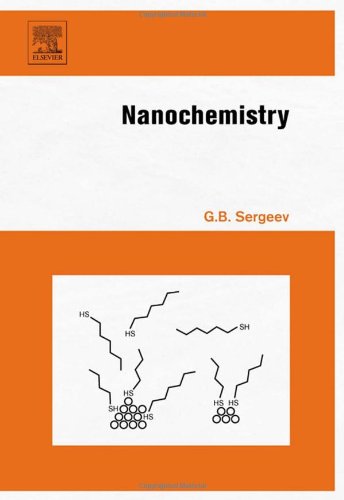(Ebook PDF) Nanochemistry 1st Edition by GB Sergeev isbn 9780080459905 0080459900 full chapters
$50.00 Original price was: $50.00.$35.00Current price is: $35.00.
Nanochemistry 1st Edition G.B. Sergeev Digital Instant Download
Author(s): G.B. Sergeev
ISBN(s): 9780444519566, 0444519564
Edition: 1
File Details: PDF, 14.47 MB
Year: 2006
Language: english
(Ebook PDF) Nanochemistry 1st Edition by GB Sergeev-Ebook PDF Instant Download/Delivery:9780080459905, 0080459900
Instant download Full Chapter of Nanochemistry 1st Edition after payment

Product details:
ISBN 10:0080459900
ISBN 13:9780080459905
Author: G.B. Sergeev
This book is devoted to nanochemistry: a branch of the actively developing interdisciplinary field of nanoscience. This branch of science studies the processes to production and reactions of nanoparticles and their compounds. It has been shown that such particles are of high activity and can undergo new and unusual chemical transformations. These transformations play an active role in our daily lives to provide reagents for self-cleaning glass surfaces and fabrics, different antiseptic coverings, sensors for monitoring the environment and catalysts preventing pollution. Nanochemistry covers the main studies of these reactions and reviews the work of leading scientists from different countries around the world. This book is the first monograph on nanochemistry, combining the elements of review and text book which allows for information on current and prospective directions in nanochemistry.
Table of Contents:
- Survey of the Problem and Certain Definitions
- Synthesis and Stabilization of Nanoparticles
- Chemical Reduction
- Reactions in Micelles, Emulsions, and Dendrimers
- Photochemical and Radiation Chemical Reduction
- Cryochemical Synthesis
- Physical Methods
- Particles of Various Shapes and Films
- Experimental Techniques
- Electron Microscopy
- Transmission electron microscopy
- Scanning electron microscopy
- Probe Microscopy
- Diffraction Techniques
- X-ray diffraction
- Neutron diffraction
- Miscellaneous Techniques
- EXAFS
- X-ray fluorescence spectroscopy
- Mass spectrometry
- Photoelectron spectroscopy
- Comparison of Spectral Techniques used for Elemental Analysis
- Cryochemistry of Metal Atoms and Nanoparticles
- Reactions of Magnesium Particles
- Grignard reactions
- Activation of small molecules
- Explosive reactions
- Silver and Other Metals
- Stabilization by polymers
- Stabilization by mesogenes
- Reactions of Rare-Earth Elements
- Activity, Selectivity, and Size Effects
- Reactions at superlow temperatures
- Reactions of silver particles of various sizes and shapes
- Theoretical Methods
- General remarks
- Simulation of the structure of mixed metallic particles
- Simulation of properties of intercalation compounds
- Simulation of structural elements of organometallic co-condensates
- Chemical Nanoreactors
- General Remarks
- Alkali and Alkali-Earth Elements
- Transition Metals of Groups III–VII in the Periodic Table
- Elements of the Group VIII of the Periodic System
- Subgroups of Copper and Zinc
- Subgroup of Boron and Arsenic
- Assemblies Involving Nanoparticles
- Group of Carbon
- Fine Particles of Carbon and Silicon
- Fullerenes
- Carbon Nanotubes
- Filling of tubes
- Grafting of functional groups. Tubes as matrices
- Intercalation of atoms and molecules into multi-walled tubes
- Size Effects in Nanochemistry
- Models of Reactions of Metal Atoms in Matrices
- Melting Point
- Optical Spectra
- Kinetic Peculiarities of Chemical Processes on the Surface of Nanoparticles
- Thermodynamic Features of Nanoparticles
- Nanoparticles in Science and Technology
- Catalysis on Nanoparticles
- Oxide Reactions
- Semiconductors, Sensors, and Electronic Devices
- Photochemistry and Nanophotonics
- Applications of CNTs
- Nanochemistry in Biology and Medicine
People also search:
application of nanochemistry
application of nanochemistry pdf
green chemistry and nanochemistry
types of nanochemistry
define green chemistry and nanochemistry
Tags:
GB Sergeev,Nanochemistry


